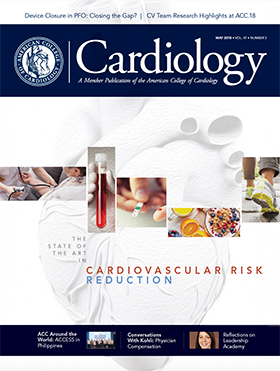Quality Improvement for Institutions | The More the Better: One Canadian Centre, Many NDCR Registries

The Peter Munk Cardiac Centre (PMCC) at the Toronto General Hospital is the first site in Canada to participate in multiple NCDR registries for adult patients. Presently they are participating in four registries, including the ACTION Registry, AFib Ablation Registry, CathPCI Registry and the ICD Registry. “We’re aiming to join the STS/ACC TVT Registry at the end of this year and the PINNACLE Registry and IMPACT Registry in 2019,” says Carolina Alba, MD, PhD, assistant professor and cardiologist in the PMCC and affiliate scientist at the Toronto General Research Institute (TGRI).
Toronto General is one of four hospitals in the University Health Network. As a tertiary referral center and major teaching and research hospital, it serves a population of 6.5 million people in the greater Toronto area. The PMCC is a referral center for patients with complex cardiovascular diseases, providing care to thousands of patients annually.
“Participation in the NCDR is the result of a mandate to participate in international quality assessment databases and benchmarking,” says Alba. The mandate was set in 2016 by Barry Rubin, MD, PhD, chair and program medical director of PMCC, for all divisions, including cardiology, cardiac surgery, cardiac anesthesia, cardiac rehabilitation and vascular surgery.
While PMCC officially joined the NCDR registries in February 2018, this was preceded by a process that started in July 2016 with the formation of the main executive committee. And before this, there was the environmental scan, digital conversion of clinical information, expansion of collected clinical data in a usable format and linking of institutional databases, which took nearly 18 months. This was a key initial step to successfully complete the process.
"We’re aiming to join the STS/ACC TVT Registry at the end of this year and the PINNACLE Registry and IMPACT Registry in 2019. — Carolina Alba, MD, PhD
Heather Ross, MD, MHSc, FACC, played a key role in managing and guiding the march from concept to launching the registries. “Along with Dr. Rubin, Dr. Ross has been a powerful engine to ensure that the project is being completed and that all the pieces and support are in place for the next stage of the process,” Alba says. Ross is the director of the Ted Rogers Centre of Excellence in Heart Function and site lead of the Ted Rogers Centre for Heart Research.
Ross initiated the clinical data integration platform with Cedric Manlhiot, PhD, director of the Cardiovascular Data Management Center and affiliate scientist at the TGRI as project leader.
“The first step was to create an inventory of all existing data,” says Manlhiot. “The legacy systems we were dealing with were not generating the kind of data we’d be able to use for case submission to NCDR. So, we developed a plan to retrofit the existing applications used in clinical settings,” Manlhiot says. Simultaneously, he notes, they developed the Ted Rogers Centre for Heart Research data integration platform, which was launched in July 2017. With this platform, data residing in multiple silos throughout PMCC are connected to a central data lake. “That was a critical aspect because it allows us to take all data from the hospital, put it in a single place, then use it to populate the NCDR registry,” Manlhiot says. In parallel, the team worked with the physicians and administration to preserve all clinical workflows and improve them where necessary.
Manlhiot credits the NCDR staff for being well organized and responsive to questions from the hospital’s Privacy Office and Research Ethics Board.
PMCC is characterized by a collaborative supportive working environment with creative, innovative and hard-working people, “which turns any challenge into an opportunity to improve,” says Alba. The main challenges were related to internal transformation of clinical data sources to ensure high-quality data collection by minimizing manual work, integrating data collection in patient care flow, avoiding duplicate work and efficiently using all available human resources from clinic clerks to physicians. “These challenges became an opportunity for reorganizing our clinical data, enforcing program interrelationships and building on the spirit of a working community to continue excelling in patient care, research and education,” Alba says.
The biggest challenge, according to Manlhiot, was integrating the process into clinical workflows. He attributes their ability to overcome these challenges and meet the milestones to join the registry to the support of both Rubin and Ross. A strong mandate coupled with an effective communication strategy allowed the effort to be successful. “This is an important take-away from our experience. We can use all the technology in the world, but if the leadership is not supportive, as in our case, it would be very difficult to implement changes in clinical workflows,” says Manlhiot.
As past president of the Canadian Cardiac Society, Ross was president of the International Canadian Chapter of the ACC. “In this role I saw the great work that was being done on quality reporting using the NCDR. The PMCC, under its medical director has a mandate on benchmarking and quality reporting against international standards. The NCDR was an ideal opportunity to achieve this and with the recruitment of Dr. Alba and Dr. Manlhiot it has become a reality!” says Ross.
Keywords: ACC Publications, Cardiology Magazine, Academies and Institutes, Anesthesiology, Benchmarking, Cardiac Rehabilitation, Cardiovascular Diseases, Ethics, Research, Data Collection, Hospitals, Information Storage and Retrieval, Leadership, Patient Care, Physician Executives, Referral and Consultation, Registries, Tertiary Care Centers, Thoracic Surgery
< Back to Listings

